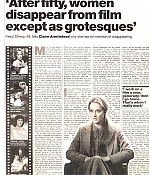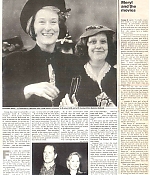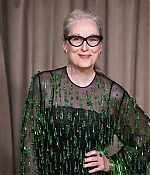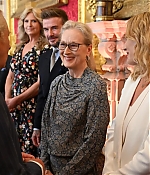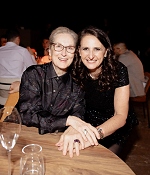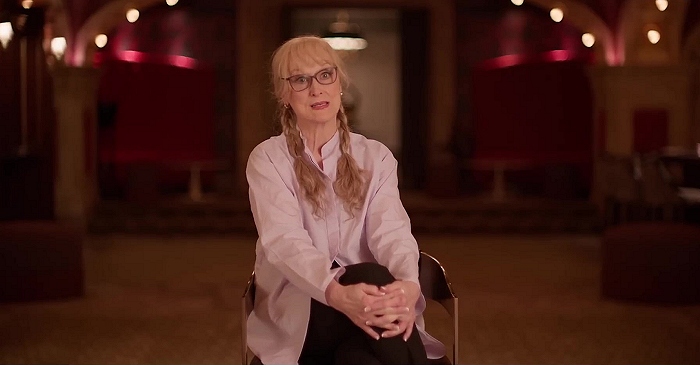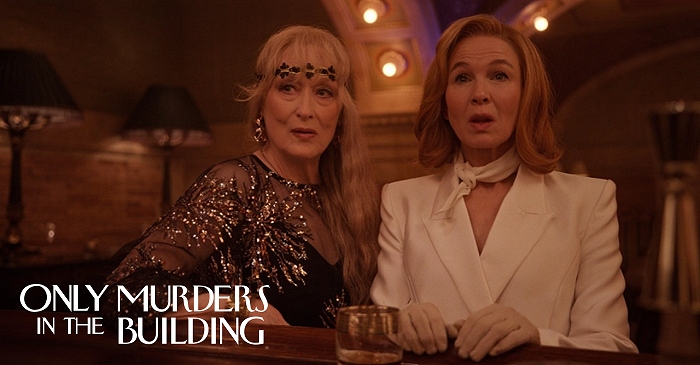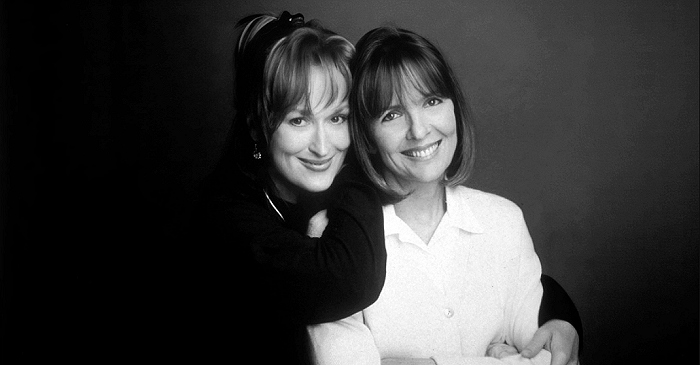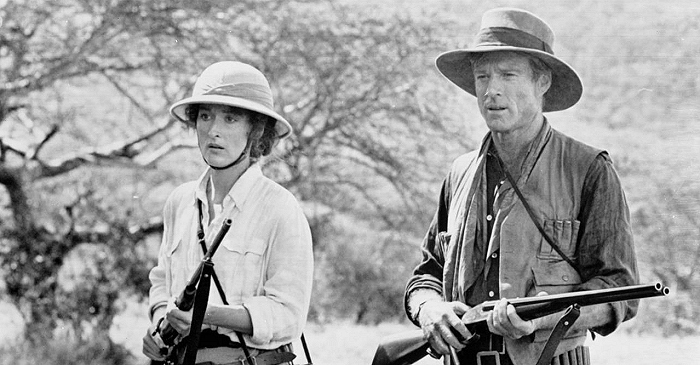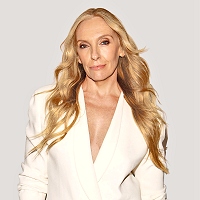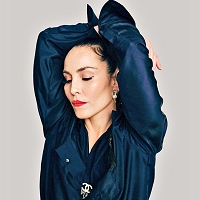|
Simply Streep is your premiere online resource on Meryl Streep's work on film, television and in the theatre - a career that has won her acclaim to be one of the world's greatest living actresses. Created in 1999, Simply Streep has built an extensive collection over the past 25 years to discover Miss Streep's body of work through thousands of photographs, articles and video clips. Enjoy your stay and check back soon.
|
|
The Prime of Ms Meryl Streep
The Guardian ·
November 27, 1998
· Written by Claire Armitstead
| ||
Meryl Streep glitters with tiredness. She’s on a black-coffee trip that has carried her from a 7am arrival at Dublin airport through two days of interviews, a meet-the-worthies gala screening of her latest film, and which will whirl her up to Donegal to go through the whole mad jig again in the village where her latest film, Dancing At Lughnasa, is set. At the Dublin press conference she gamely plays along with questions about Ireland (one of her daughters is called Grace after an Irish ancestor) and, of course, Guinness. (“I had a number of pints and after that it didn’t matter how I did the accent.”) Someone asks if she knows she’s known as Myrtle Sheep by chat-show king Gay Byrne (“I suppose it’s a sign of love”). And when a young woman pipes up in awed tones that she’s hardly aged at all, she musters a hearty laugh and, yanking at the back of her neck, says it’s actually a rubber-band holding her face in a perma-grin. You can see where the awe comes from. It’s not just that this is a masterclass in self-control. It’s that it’s hardly believable that this sleek woman is the same one she has come to sell us. In the film of Brian Friel’s award-winning play about a Donegal childhood, Streep is a middle-aged schoolteacher with a face as plain as soda bread, known to her pupils as ‘the gander’. She’s the oldest and sternest of five spinster sisters, who squabble and cluck over the two men in their lives: their brother, a ruined whiskey priest, and the love child born to the liveliest and prettiest of the sisters.
It’s not what you’d call a flattering role. Catherine McCormack is the looker, as the wild Christina, while Kathy Burke and Sophie Thompson have a high old time the graceless and gormless remaining siblings. Streep, in many shots, is simply the pursed lips in the corner. Isn’t there a teensy bit of her, a Big Star bit, that minds this eclipse? Not at all. “This is my way of getting back into the theatre, without having that sort of schedule; to work as an ensemble, with all the actors intensely involved with each other and discovering those parts. Very often in film you just come in and say hello and start up, and it’s very spontaneous and it has its own particular life, but it isn’t the same.” Streep speaks so carefully and slowly, in that East Coast lilt of hers, that the answers to your questions keep coming after the next question has been fired. There are some surreal snatches when we talk in tandem as if in some bizarre jamming session. “I love these girls and boys,” she says of the Lughnasa crew, as I attempt to pop in a question about how how she copes with difficult co-stars. Charles Dance, who co-starred in Plenty, was less than complimentary. Dustin Hoffman, after Kramer vs Kramer, said: “I hated her guts, though I respect her as an actress.” You can see how they might feel threatened. She has a way of doing what, if you were Pauline Kael in a spiteful mood, you would call laughing from the neck up – throwing her head back in a way that can seem dismissive, despairing or exasperated, according to the prevailing mood. You can track that laugh back through her films.
It was Kael whose response to Streep’s Oscar-winning Sophie’s Choice was the now famous jibe – that it was impossible to imagine her from the neck down. It has been thrown at her so often that she has developed a pretty effective pre-emptive strike. “It’s taken me a long time to evolve a sensibility that understands that that space where they say pause is often where the whole movie happens. For years, I would just gloss over the description of things, so I’ve had to learn to respond in a different way, but I do still love the curlicues of interesting language.” This love of language has been something of a fatal attraction in a medium where the image is paramount. Remember how she rinsed the phrase ‘I had a farm in Aafricaa’ around her mouth in Out Of Africa with such a swoosh of vowels that it has long-since passed into the folk-joke memory? Yet it is once again language that has brought her to Lughnasa, a play that – significantly – she never saw on stage, only read. “In this case, language is characters and revelatory of the souls of these people. The way they frame their words is the way they frame their lives. I don’t know why I respond to things that way. I guess maybe because I read plays a lot when I was a kid.” She was born in New Jersey, the first child of an advertising executive and a commercial artist. Her parents are in their eighties now, and frail, but they are very close. In Dublin, she panics her hosts by informing them that her mother is sick and she might have to catch the next plane home. “My mother said she was the oldest living mother,” she tells me. “She started having kids at 35 which, in the forties, was incredibly old… I think they didn’t intend to have children. I don’t think he wanted them. I think I was an accident, but then they had two more because they were so besotted.” Mentioning family, in Streep’s case, is not simply a question of biographical mulch. Her whole vocabulary revolves around it. She explains her sometimes tricky relationship with her co-stars by saying: “I’m just an actress who goes home to my family after finishing work. I suspect this is why I’m thought of as rather distant.” Mary Louise Streep (Meryl came later) was a big sister among brothers, a clever – and, history would have it, goofy – girl who was put through an exclusive education, culminating in a drama scholarship at Yale. She was on the New York stage, in The Taming Of The Shrew, when she was spotted by Karel Reisz, who later cast her as The French Lieutenant’s Woman – the role that froze her in the international eye as the statuesque woman at the end of The Cobb. It’s hardly surprising that she needed to use her elbows here and there, since she emerged from possibly the most macho era the movies have ever known – the era of The Godfather and Raging Bull. She made her first impact with roles that were really not roles at all, clawing an identity from the Vietnam buddie-movie The Deer Hunter (1978). In Kramer Vs Kramer, the following year, she was the dame who was, quite literally, pushed out of the frame – who insisted on rewriting her part to give Dustin Hoffman’s estranged wife a chance to explain herself. She did so, she says, with only partial success. “She was not sympathetically regarded in the American press, but at least she got to say who she was.”
Streep has come to personify a particular kind of intelligent woman – about as far removed from your average Hollywood airhead as anyone on the wrong side of a movie camera. In the late seventies, she took centre-stage in one of the decade’s big love stories as she nursed her boyfriend – the actor John Cazale – through bone cancer. But she let it be known she wasn’t any old saint: when he was diagnosed, it wasn’t to healing manuals that they looked but to Susan Sontag’s hefty essay, Illness As Metaphor. Less than a year after his death, she had moved on and married the sculptor Don Gummer – and she has remained married to him ever since. For a while, she combined the roles of artist’s wife and Hollywood mum. She laughs at the memory. The art world was all cool black suits, while the baby-scene was pure Tinseltown. “The mothers in the baby group were all stars. It was so disconcerting. I was not comfortable.” So they got the hell back to Connecticut, where their friends now are people who live within driving distance – and where she had no problem finding an Irish ‘fella’ who could put her through her dance steps for Lughnasa. It is, she says, “a rural area of 5,000 people – if you really walk far away from the centre of town, you can find that many people. And, um, no, we don’t walk the red carpet every day and ride in limousines. I’m sure it’s perceived as perverse, but lots of people who work in movies don’t live large, mostly because actors are scared to death that they’ll never work again.” She describes herself as the conservative child of parents who lived through the Depression. “I’ve always, you know, saved my money, paid off my loans, don’t live on credit.” So is this conservative child worried that the work and the cheques will stop coming? After all, numerous writers have pointed out that her movies have rarely lived up to the promise of an actress who was hailed as ‘the Eleanor Roosevelt of acting’ and ‘the next major American actress to be offered everything’. No, she says, because she regards herself as first and foremost a mother to her four children, now aged between seven and 18. “I stop work all the time. That’s the way I arrange my life. I work on a film a year generally… then I go home and work… that’s when I really work… when I go back on a film set, people get me coffee and stuff.” A few years ago she made The River Wild, an almost John Ford-like action movie with Streep the heroic mum at the oars of a careering dinghy in the rapids of wildest America. It might not have been the world’s greatest movie, but she was terrific in it; quite different from the fidgety Italian of her menopausal romance with Clint Eastwood, The Bridges Of Madison County.
Rumour has it that she made The River Wild to provide a role-model for her daughters. “It was partly true. What I wanted to do was let them see something on screen where a woman was physically brave without picking up a sub-machine gun in a preposterous way.” “It depresses me on behalf of my children because I want my son and my girls to see all kinds of people in the movies, to reflect what they see in life. The fact that after 50, women disappear from film except as grotesques tells our children something. It sends a message that older women are not valuable, are not interesting.” Why, I wonder, should that be. She gives that laugh again. “A studio executive reads a script and decides whether it personally interests him. If he has a new 25-year-old wife or girlfriend, he is not going to be interested in a story about his first wife unless he’s a highly evolved person. “It’s just as if I were the head of a studio and I read three scripts in a row about an older man with a 25-year-old girlfriend, I wouldn’t identify with it or be interested in it and I wouldn’t probably greenlight it. I think you just have to look at the parents to understand the children. The parents are the people who pay for the movies and the children are the movies.” So would she ever take a cue from this and go into producing herself? “Not remotely. I don’t have time. I have too many children. I have responsibilities.” There was a hurtful little episode recently when she and Glenn Close approached the English director Richard Eyre to direct them in a film version of his National Theatre production of Schiller’s Mary Stuart. It was all set up and then Streep backed out, putting the financial backing in jeopardy. Her excuse to Eyre was simply that her heart was no longer in it. You can see why she would admire an English theatre director – she loves the stage, but insists she won’t be following the troop of movie actors heading for London. It’s those children again. “I can’t be gone every night and all weekend.” I wonder if there isn’t a bit of her that regrets the films she has missed. She’s reputed to have hissed ‘I’ll tear her throat out’ when Madonna pipped her to Evita. But what else is a woman to say? “Well,” she admits, “I did yell at Karel Reisz because he cast Jessica Lange in Sweet Dreams, which I’d always wanted to do, and I made him give me his house while I shot Plenty.” The theme of motherhood – gnarled and vicarious in Lughnasa, tiger-like in The River Wild – has yet another manifestation in her next movie, One True Thing, which has just opened to fine reviews in the States. In it she plays a dying woman whose career-girl daughter comes reluctantly home to see her out. The New York Times last week hailed it as no less than the start of a new era for the female film; the New Yorker saw it as a rebirth for Streep. ‘It’s as if she had gone and cleaned everything out – all the technical virtuosity that enabled her to change accents and inhabit wildly differing roles with ease… She looms large, even after she’s gone, the way mothers have done since the beginning of time.’ Next year, she turns 50 and her son reaches adulthood. You might not know it from Dancing At Lughnasa, but this could yet be the decade that the Eleanor Roosevelt of acting gets back on course. And being Eleanor Roosevelt, she’s almost bound to take the world with her.


